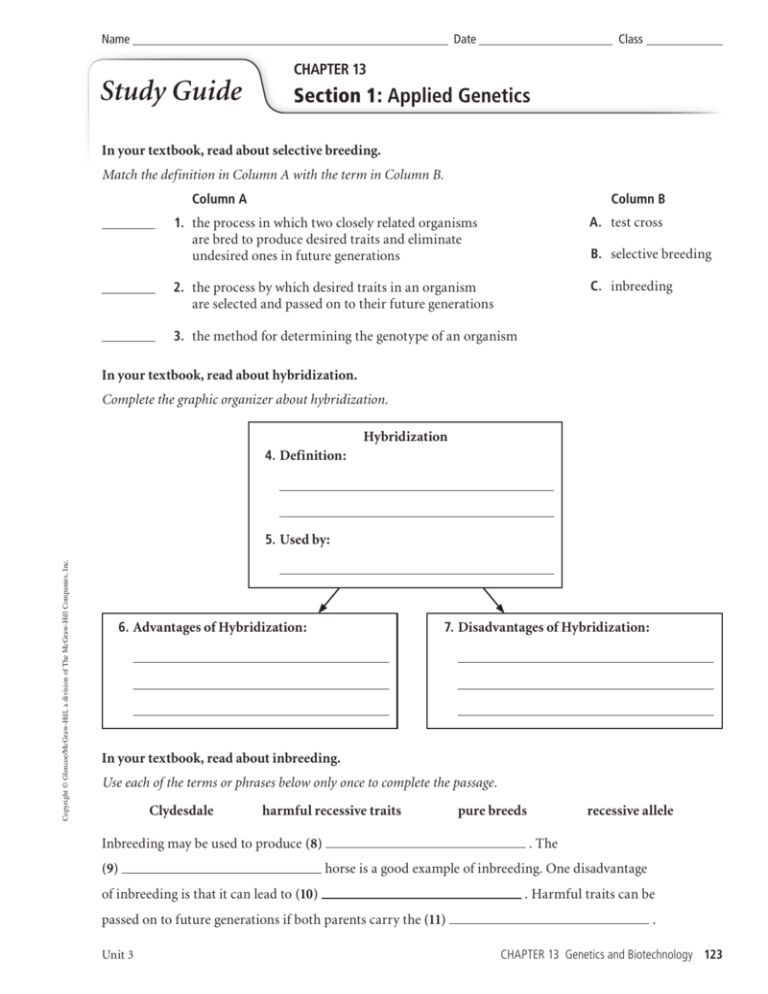Genetics & Biotechnology Study Guide: Chapter 13
advertisement

Name Date Class CHAPTER 13 Study Guide Section 1: Applied Genetics In your textbook, read about selective breeding. Match the definition in Column A with the term in Column B. Column A Column B 1. the process in which two closely related organisms are bred to produce desired traits and eliminate undesired ones in future generations A. test cross 2. the process by which desired traits in an organism are selected and passed on to their future generations C. inbreeding B. selective breeding 3. the method for determining the genotype of an organism In your textbook, read about hybridization. Complete the graphic organizer about hybridization. Hybridization 4. Definition: Copyright © Glencoe/McGraw-Hill, a division of The McGraw-Hill Companies, Inc. 5. Used by: 6. Advantages of Hybridization: 7. Disadvantages of Hybridization: In your textbook, read about inbreeding. Use each of the terms or phrases below only once to complete the passage. Clydesdale harmful recessive traits Inbreeding may be used to produce (8) (9) recessive allele . The horse is a good example of inbreeding. One disadvantage of inbreeding is that it can lead to (10) passed on to future generations if both parents carry the (11) Unit 3 pure breeds . Harmful traits can be . CHAPTER 13 Genetics and Biotechnology 123 Name Date Class CHAPTER 13 Study Guide Section 2: DNA Technology In your textbook, read about DNA technology. Complete the table by using each term in a sentence. Vocabulary Term Sentence 1. Genetic engineering 2. Restriction enzymes 3. Gel electrophoresis 4. Recombinant DNA 5. Plasmids 6. DNA ligase 7. Transformation Copyright © Glencoe/McGraw-Hill, a division of The McGraw-Hill Companies, Inc. 8. Cloning 9. Polymerase chain reaction 10. Transgenic organisms In your textbook, read about genetic engineering. Use each of the terms or phrases below only once to complete the passage. desired traits expressed Selective breeding produces organisms with (11) genetic engineering actually changes how a specific (12) , while is in an organism’s offspring. (13) 124 gene Genetics and Biotechnology CHAPTER 13 Unit 3 Study Guide, Section 2: DNA Technology continued In your textbook, read about DNA tools and recombinant DNA. Complete the graphic organizer about recombinant DNA. Recombinant DNA Cloning DNA sequencing Polymerase chain reaction 14. Purpose: Purpose: to produce very large numbers of identical DNA molecules 15. Purpose: Write the term or phrase that best completes each statement. Use these choices: gel electrophoresis Copyright © Glencoe/McGraw-Hill, a division of The McGraw-Hill Companies, Inc. 16. Scientists use 17. A process called 18. During PCR recombinant DNA technology restriction enzymes to cut DNA into smaller fragments. separates DNA fragments by size. , DNA fragments move to the positive end. 19. starts with a primer. 20. are bacterial proteins. 21. combines DNA fragments from different sources. 22. A technique called Unit 3 copies a specific region of DNA. CHAPTER 13 Genetics and Biotechnology 125 Name Date Class CHAPTER 13 Study Guide Section 3: The Human Genome In your textbook, read about the Human Genome Project. Use each of the terms or phrases below only once to complete the passage. cleaved Human Genome Project protein-coding sequences The (1) DNA fingerprinting noncoding sequences Escherichia coli nucleotides was completed in 2003. Its goal was to determine the sequence of all the (2) of human DNA. Scientists prepared for the HGP by starting . To determine one continuous human genome sequence, small, using (3) each of the 46 human chromosomes was (4) . Most of the sequences have no direct function and are called (5) sequences are (6) , while less than 2 percent of the . The DNA sequences unique to each individual were determined through (7) . In your textbook, read about DNA fingerprinting. Imagine that you are a detective trying to solve a crime that occurred ten years ago. You have DNA from the crime scene. Write a summary of how you might use DNA fingerprinting to solve your mystery. Copyright © Glencoe/McGraw-Hill, a division of The McGraw-Hill Companies, Inc. 8. In your textbook, read about the genome and genetic disorders. Complete the graphic organizer about SNP. Single Nucleotide Polymorphism (SNP) 9. Definition: 10. Function: 126 Genetics and Biotechnology CHAPTER 13 Unit 3






